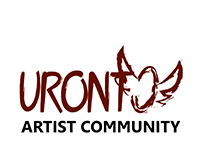
05 Feb URONTO Residential Art Exchange Program- 4th Episode
In the Forth Episode like every other Episode URONTO located the exchange program in a new spot. The location was a more than 300-year-old Jaminder building- Lakutia Jaminder house in historic village Lakutia in Barisal Division, Bangladesh.
Barisal is one of the seven administrative divisions of Bangladesh. Located in the south-central part of the country. In 1797 the area was established as Bakerganj District but later renamed as Barisal District. Barisal is full of old architectural structures which contains a lot of untold history of time. Many British structures have been refurbished and many are left abundant.
Lakhotia village is a historical village, about 5/6 miles from Barisal town. About a 40-minute journey from the city area. It was one of the major places where the brutal killing took place during the 1950 riot in Barisal. On Feb 15,1950 Muslims started looting and burning Hindu houses and killed more than thousands of people in that area.
The Lakutia Jaminder house is simply known as the house of the king in the village. It was made by king Raj Chandra Roy almost 300 years ago. The famous six kilometers long Rayer Khal (Rayer canal) was excavated from Lakutia Zamindar Bari in early-British period and joined with Jail Khal (jail canal) in Natun Bazaar (new market) area of the city. Now it is an abundant building standing alone. The side area of the building is used by the local agricultural department as seed storage. The main building is standing as ruins. The front roads have very old Hindu monastery on one side and small temples on the back area of the land too. As a whole, the huge area contains a lot of dimensions of old structures. The original history and memories related to this house is almost lost and hard to find. But extend history while the partition time can be found and some members have been also located in some areas on the both side of the border, which can help finding the lost history and memories.

In this project, the participants were invited to portray the ruined diverse beauty of the house, the lost history, the truth even why not myth as well through their distinctive media. The truth is, only a very small part is standing quietly there but a larger part is silent in the members of the house and among the village peoples memory. Participants were expected to bring out all those silent memories and beauties in this episode and bring out an esthetical expression of their findings and realization.

Participants explored local libraries and theorists and found very interesting contents. They worked with different time, community and activity around the house. Some worked with border issue related to the place and also the Riot that took place at the spot. Local painters and student of fine arts participated generously. A drawing workshop and a theater workshop was conducted with the local children. Local journalists and researchers were fantastically supportive and helped a lot to dig out the history of the place. Many things are changing fast there as the land is under the Agricultural department of Government but still the locals are trying their best to bring awareness to preserve the palace.
Selected artists/participants in the project were: Aditi Gupta(India), Jinal Patel (India), Sisir Thapa(India), Tapash Sarkar (India), Hamida Khatri(Pakistan), Tasmin Choudhury(Bangladesh), Farhad Rahman (Bangladesh), Fahad al Alam(Bangladesh), Shahriar Shihab(Bangladesh), Nazim Udding Khan (Bangladesh), Chandra Shukhen (Bangaldesh) and the local school student and the two-journalist named Shukumar and Shwapan.
The project started from 02 Jan and ended with an open studio day on 09 Jan 2015.
Detail of all the works done in the Programme will be soon uploaded in the archive section.
URONTO is hosting site responsive residential art exchange programmes since 2012, within disused or abandoned spaces and heritage buildings to document cultural memories and brand Bangladesh globally through multidisciplinary artists’ collaborations. URONTO’s activities not only provide much-needed opportunities for emerging artists to expand their working practice and collaborate with international artists, but through each residency, they create an alternative documentation about the history of the selected site before it’s demolished and forgotten.
The Project invite artists and practitioners through open call and selects then through a curatorial board created newly for every Episode. It is an international program open for all kind of discipline.




No Comments